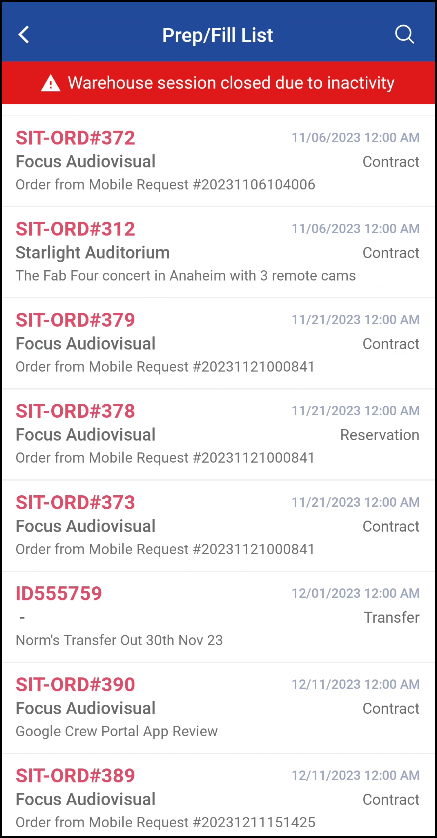Idle Timeout Management
The app monitors your activity once you open a warehouse task. If there is no interaction (e.g., touch, swipe, or tap) for a certain period, the session will automatically close. This feature is designed to ensure that inactive sessions don’t remain open unnecessarily. If you stay idle for a predefined period, the app will automatically log you out, ending the session.
The idle timeout is considered from the R2 Configuration module. If the idle timeout value is not set / empty / zero in R2 configuration module, PackNShip app will enforce a default timeout of 30 mins.
The session timeout feature applies to the following workflows:
Prep
Ship
Return
The Batch Return and Item Lookup workflows do not have the session timeout feature enabled. These workflows will continue to stay active, regardless of inactivity.
When your session times out due to inactivity, the app will display a red notification informing you that your session has closed.

Image 1.0: Session timeout message
The session will continue to be tracked even if you minimize the app or put it in the background. The timeout period will still apply If you remain inactive for the timeout period, your session will still close, and you will see inactivity message when you bring it to active.
Syncing and Saving Changes After Timeout
If you made any changes during your active session, such as modifying orders or inventory, those changes will still be saved or synced to the respective order and inventory systems. This ensures your progress is not lost after the session ends.
Order Lock Release After Session Timeout
If you were editing an order that was locked, the app will release the lock on the order after the session times out. This makes the order available for others to edit, ensuring no conflicts in order management.
The lock will only be released after the last user session is closed. If multiple users are working with the same order, the lock will only be released once all their sessions have ended.
Limitations
Only keys that input text, such as letters, numbers, characters (including emojis), and the backspace key, will be detected as user activity and will reset the timer. Other keys, such as Shift, Caps Lock, and mode switches (alpha/symbol/emoji), are not considered user activity as they do not input characters but only adjust keyboard settings.
User interactions within the PDF Print dialog for Picklist and Delivery Receipt are not detected as user activity. These dialogs are external to the app, and no feedback is relayed back to the application.
On iOS, when the app is minimized, moved to the background, or when the screen is turned off, the app is suspended by the system and cannot process user activity. Consequently, the warehouse session will not automatically close during the timeout period. It will only close when the app is reopened after the timeout has elapsed.
If the user forcefully closes the app (e.g., by swiping up) on either Android or iOS, the warehouse session will not automatically close after the timeout period. The session will only close when the user reopens the app.
Note:
Some Android devices still offer physical or digital navigation buttons (Home, Back, Recent Apps) as an alternative to swipe gestures.
Pressing these navigation buttons is not detected as user activity, as they are external to the app, similar to the keyboard.
Swipe navigation gestures may or may not be detected as user activity, and behavior can vary depending on the device and OS version.
OS/Device | What is detected as user activity involving swipe navigation gestures |
|---|---|
iOS |
|
Android | None. However, the first time the app is brought back to the foreground after using swipe navigation gestures (to navigate to the home screen or switch to a different app) is detected as user activity and thus resets the inactivity timer. |
